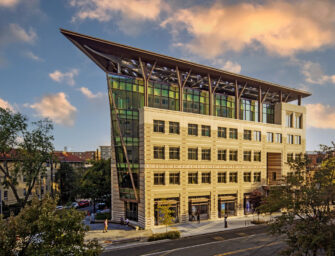Laissez Les Bons Temps Rouler! 2017 Fall Meeting in New Orleans
It wasn’t your grandfather’s AGU that met this month in New Orleans for the first time. As in recent years, it was just as large (with nearly 23,000 registrants from 92 countries, more than 9,000 oral abstractsand 13,000 poster abstracts), but the innovations, energy, and vibrancy took us to new levels!

A photo of the discussion pods located outside Registration at AGU17.
Innovations: How to make a huge meeting feel more manageable?
- Discussion pod options were increased, allowing attendees to converse with old and new colleagues in a dedicated spot outside of the scientific sessions to continue their conversations.
- Scientific neighborhoods organized oral and poster sessions in a more relatable fashion, grouping sections into four neighborhoods: Earth Interior, Earth Covering, Beyond Earth, and Science Nexus.
- eLightning presentations enabled interactive electronic posters, projected on a 52″ touch screens, providing dynamic, interactive, multifaceted, digital platforms to encourage more in-depth discussions and increase overall visibility for presenters’ work.
- An awesome app allowed attendees to find event information, abstracts, and much more when they needed it.
- AGU On-Demand was expanded to reduce our carbon footprint and to allow those who couldn’t travel to stream live content and to view on AGU’s YouTube channelafter the meeting (try it now).
- “Safe AGU” advanced an inclusive and diverse environment and featured 16 events on ethics, bystander training, broader impacts, and much more.
Development across the career cycle
- More than 7000 students attended Fall Meeting: they gave nearly 3000 presentations as part of the Outstanding Student Paper Award Program; nearly 400 attended the student breakfast; and more than 100 participated in the Student and Early Career Scientist Conference.
- Over 600 attendees took advantage of the Career Center services, including workshops, mentoring sessions, and resume and C.V. reviews.
- Talent Pool development was featured in 23 education events and 3 education sessions, including Heads & Chairs workshops, the Bright STaRS poster sessions, Undergraduate Mentoring Programs, and much more.
- Celebrating the scientific achievements of some of our most accomplished members, we honored 61 new Fellows and 28 medalists, awardees, and prize recipients at our honors ceremony. We also honored several more awardees and prize winners at other section-sponsored events, including winners of our first Open Data API Challenge.
Plenaries, science policy, and late-breaking sessions

Eric Davidson, AGU President, introducing Dr. Don Boesch at the Why We’re Still In keynote session.
- In the Presidential Forum, veteran journalist, Dan Rather, related his personal journey, from learning about nature as a young boy in rural Texas to seeing today’s alarming impacts of climate change on the environment, health, and the economy. Rather admonished scientists to “tell their stories” of inspiration drawn from scientific discovery as the best means of spreading appreciation for science in society.
- In a special plenary around the We Are Still In movement, moderated by Dr. Don Boesch of the University of Maryland Center for Environmental Science, three representatives from city governments, The Honorable James Brainard, Mayor of Carmel, Indiana; Sra. Tanya Müller García, Secretary of the Environment of Mexico City; and The Honorable Jeff Hebert, Deputy Mayor of New Orleans, described the importance of their efforts to reduce greenhouse gas emissions at the local level and build resilience to climate change. Their efforts and concerns apply across national borders and political parties, and from small towns to megacities. A special performance by peer reviewed science rapper Baba Brinkman [w]rapped up the session.
- In the Frontiers Lecture, Dr. Joanna Morgan, Professor of Geophysics at Imperial College London, recounted her fascinating career-long journey in exploring the Chicxulub impact crater created by the meteorite that led to the extinction of dinosaurs, explaining the process by which rock briefly turned to liquid.
- In the Agency Lecture, Dr. Vaughan Turekian, U.S. National Academy of Science, described his career as a science advisor at the U.S. State Department. Having followed a non-traditional career path, Dr. Turekian encouraged young scientists to broaden their knowledge and experiences by taking advantage of internships and fellowships relating science to societal concerns.
- Policy issues, science communication, and community science were at the forefront this year in our 23 science policy events, 30 Sharing Science events and sessions, and 17 Thriving Earth Exchange Science-to-Action presentations.
- Several late-breaking special sessions addressed recent hazards including hurricanes that have struck the U.S., Mexico, and the Caribbean islands, severe flooding in Asia, the Oman Ophiolith drilling project, North Korea’s nuclear tests, and earthquakes in Mexico.
Mixing fun and science
- This year, AGU field trips offered local insights into areas such as New Orleans infrastructure, Katrina impacts and recovery, inner harbor storm surge management, and LIGO Livingston.
- Many sections had mixers at the Mardi Gras World – words don’t describe the fun at this event, you had to be there!
- Traditional NOLA “second line” marching bands paraded members from evening events back to hotels, allowing even some of us introverted science nerds to unwind.
- Personal best Fitbit and pedometer records were set every day by walking the 1.2-mile long convention center. This proved to be a good antidote to the amazing NOLA cuisine.
In 2018, Fall Meeting in Washington, D.C., will no doubt have a different flavor than this year, and in 2019, we look forward to going “back home” to San Francisco for our Centennial. For now, New Orleans is etched in our memory as a high point in experimentation and innovation and a turning point for what the AGU Fall Meeting can be. It is au revoir to NOLA for now, mais peut-être que nous reviendrons!




There are no comments
Add yours